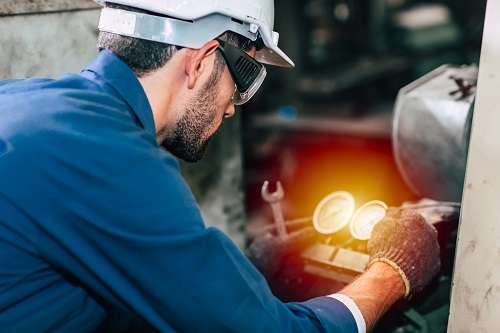Table Of Contents
'Maintenance' Redefined
A key to understanding Machine Maintenance is to first define what we mean by the word 'Maintenance'. Often, in factories, the word Maintenance can mean a few different things.
- The department in the company we charge with keeping machines running
- The area of the facility where the mechanics store their tool boxes and parts
- The physical action or taking care of and repairing the equipment (Preventative Maintenance, Planned Maintenance, etc.)
In order to fully comprehend and improve the way we do machine maintenance in our factories, we must all agree that when we say the word 'Maintenance', we are talking about the types of systems and processes we have chosen to take care of the equipment. So, the term Machine Maintenance is both the system and the process we have chosen to take care of the production machines. With that in mind, we can then look at those systems and processes for waste elimination and improvement.
Reactive Machine Maintenance
Whether you realize it or not, one type of Machine Maintenance process many factories 'choose' is Reactive Machine Maintenance. Yes, I said a reactive maintenance process. This is just what it sounds like: the reaction to an unplanned event on a piece of equipment. Reactive Maintenance is often looked at in a highly negative light, and in most cases it should be, but there is great value to be had in recognizing that reactive maintenance is a vital part of your Machine Maintenance process. A Firefighter is always ready to battle the inevitable fire that nobody wants to fight: Training, processes, and protocols need to be in place to make the fire fighting as safe and efficient as possible. The same holds true with Reactive Maintenance.
One great mistake made by even really, really good maintenance departments all around the world, is that they do not "plan" for Reactive Maintenance. Although we hope to achieve very few occurrences of Reactive Maintenance, it is and will always be inevitable in the Machine Maintenance process. Much like any and all of the other processes in your business, Reactive Maintenance contains waste. If we do not take the time to identify those instances of waste, eliminate those wastes, and build Standardized Work in order to ensure waste does not return, we will continue to suffer the same downfalls in relation to Machine Maintenance and Reactive Maintenance that come from wasted time and motion as found in any other process.
Waste in Planned Machine Maintenance
Planned Maintenance is another common and vital part of the Machine Maintenance process. Reactive Maintenance waste not only happens when unplanned downtime occurs, but Reactive Maintenance waste can happen when, in the middle of a Planned Maintenance event, the technician goes off script and decides to repair something in addition to what is planned. In this scenario, all of the waste that comes with a reactive call (no parts, wrong skills, incomplete instructions, etc.) happens now as well.
It is important to have good, well defined standard work and protocols around your Planned Maintenance activities. As part of your Machine Maintenance program, Planned Maintenance should include protocols such as: if a defect or abnormality is found during the Planned Maintenance event, and if it will not immediately impact Safety, Quality, or Throughput, the mechanic should document the abnormality in a Work Order instead of beginning an unplanned repair.
Hopefully, your CMMS affords you this flexibility. If L2L's LES (Lean Execution System) is your CMMS, than it sure does, and you and your teams already know that. Our LES allows you to document and relate activities as well as escalate issues based on severity and urgency. If your CMMS does not allow you to capitalize on just these types of opportunities, then you might consider a more robust, one stop shopping solution, like L2L.
The goals and aspirations of a good Planned Maintenance program should be to ultimately create maximum uptime for the factory. Eliminating waste in the Planned Maintenance process will create additional time for resources and mechanics to perform even more efficiently planned machine maintenance tasks.
The Support Organizations Role
In many organizations, the role of Machine Maintenance is the last thing on the minds of support departments such as HR, Training, Sales and Marketing, for just a few examples. But nothing could be further from the truth. Each department in the company has, in some way or another, a direct impact on the performance of the equipment. Think of it this way, if all of the equipment were to fail and we make the decision not to maintain it, is it only the maintenance and production personnel who will suffer the ill effects of this decision? No, every department in the company is impacted. So, measures and systems should be put in place to eliminate waste in these support processes as well in order to support the overall 'maintenance' process.
Let's take Human Resources as our example. Our current culture in manufacturing, or any business that depends on the skilled trades for that matter, is in a constant search for well trained, highly skilled trades people like maintenance personnel. Understanding their role as a part of a greater machine maintenance program, HR may very well change the way their representative looks at the responsibility to hire and train new mechanics for the shop floor. Similar examples can be made for how Product Design groups design products with ease of production and maintenance in mind, or how Purchasing departments can have a greater impact on uptime in the parts they buy and stock and so on. It is critical for every member of your organization to realize and understand how each department depends on well maintained, properly functioning equipment to make the company profitable.
We have all learned that eliminating waste from processes is a vital part of a company's profitability and viability. But we have often neglected to implement these principles in the Machine Maintenance processes. Doing so is the next step of improvement for our factories.
So what are the wastes that exist in the maintenance process?
Well, a few of them are fairly obvious, but there are a few that are often overlooked and can contribute to the overall accumulation of downtime. These wastes can include:
- Finding what jobs are available
- Defining the job itself
- Researching the infamous "see me for details" work order
- Looking for information
- Waiting for machines to become available
- Searching for information (manuals, drawings, instructions)
- Looking for parts
- Looking for tools
- Travel time to and from the job
- Getting pulled from jobs before completion
7 Wastes Found In Maintenance
If we look at the traditional 7 wastes of Lean Manufacturing, we can see a direct correlation between the waste we see in maintenance and the waste we see in Lean.
- Overproduction = Unnecessary Repairs
- Delay = Waiting For Resources, Machines or Parts
- Transportation = Traveling to and From Repairs
- Processing = Performing Repairs to Standards
- Inventory = Incorrect or Not Enough Spare Parts Inventory
- Motion = Unskilled or Untrained Resources Performing Repairs Improperly
- Defect = Incorrect Repairs or Fixes
In reactive mode, a maintenance job can cost anywhere between 4-10 times more than a planned maintenance activity. Through the same practices used in any other lean initiative, maintenance organizations can apply the same problem solving techniques as performed in the production or support processes to reduce and remove waste in the machine maintenance process.
Learn how L2L's next gen CMMS makes machine maintenance easier to manage.




